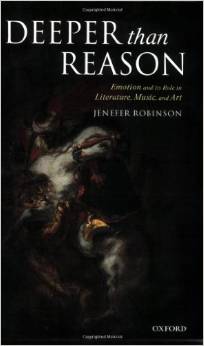 Jenefer Robinson, Department of Philosophy, University of Cincinnati
Jenefer Robinson, Department of Philosophy, University of Cincinnati
November 2014 – The relationship between music and emotion is among the most contentious issues in the philosophy of music. People differ about (1) what it means to understand music and whether emotion plays a role in musical understanding, (2) how music expresses emotions, (3) how music arouses emotions, and (4) whether the expression and/or arousal of emotions is important to the aesthetic value of music.
Musical Understanding
To understand the representational arts such as painting, movies, and literature, you need to understand what they are about: what the painting or movie depicts, and what the poem or the novel describes. In contrast, the founder of contemporary musical formalism, the nineteenth century music critic Eduard Hanslick, maintained that musical beauty “is self-contained and in no need of content from outside itself.” It “consists simply and solely of tones and their artistic combination” (Hanslick 1986, 28). Music is created out of “the entire system of tones, with their latent possibilities of melodic, harmonic, and rhythmic variety” (ibid.). In other words, to understand music is to grasp its harmonic, melodic and rhythmic structure or form. To understand the 12-bar blues, for example, you need to hear the fixed harmonic progression supporting the vocal line (4 bars on the tonic, two on the subdominant, followed by two on the tonic, two bars on the dominant 7th and two concluding bars on the tonic). To understand Beethoven’s Fifth Symphony, you need to hear how the famous Fate theme or melody (Da-da-da-DUM), which is elaborated creatively throughout the length of the work, lends unity not only to the first movement but to the symphony as a whole.

Hanslick was very concerned to establish that music has no “extra-musical” content, and that, in particular, it does not express or represent emotions. One of Hanslick’s contemporary devotees goes so far as to say that “it is not essential to music to possess emotion, arouse emotion, express emotion, or represent emotion. Music, in itself, has nothing to do with emotion” (Zangwill 2004: 29). In other words, music in itself is nothing but complex structures of tones, a bit like the moves in a game of chess.
Despite adhering to the formalist position, the music theorist Leonard Meyer has argued that the emotions can nevertheless play a role in understanding music. His ingenious idea is that if you have heard a lot of music in a particular style, you will have expectations regarding how the music is going to unfold. If, relative to such expectations, you are in turn surprised, bewildered, disappointed and satisfied by what happens in the music as it unfolds, this can be an indication of musical understanding, even if you are not trained in harmonic analysis (Meyer, 1956). The psychologist John Sloboda suggests that music can elicit thrills and chills when it “[teases] structural expectancies” by “repeatedly creating and resolving tensions.” (Sloboda 1999). Moreover, even formalists agree that great music can elicit emotions of admiration or excitement when its melodic, harmonic and rhythmic structure are appraised as beautiful and well-crafted (Kivy 1990).
The Musical Expression of Emotions
Most listeners, however, think that there are far more important relationships between music and the emotions than those countenanced by formalist theorists. Almost all music accompanied by words, from the Beatles’ ebullient “I wanna hold your hand” to Adele’s wistful “Someone like you,” seem to express powerful emotions. Are these emotions the composer’s or the performer’s or both? Even though the performer appears to be expressing her own emotions (and perhaps channelling those of the composer), on reflection it is the “character” impersonated by the singer whose emotions are being expressed. If a singer were actually experiencing deep grief, she would likely be unable to sing at all. Just as the actor impersonating Hamlet is expressing Hamlet’s world weariness when he says “Oh that this too too solid flesh would melt…,” so, when Adele sings “Sometimes it lasts in love but sometimes it hurts instead,” she is expressing the emotions of the fictional character she is impersonating in the song, even though such emotions may occasionally mirror her own grief and hurt.
Things get more complicated when it comes to ‘pure’ instrumental music. According to some philosophers, this sort of music is rarely, if ever, a genuine expression of anyone’s emotions. When we say that a piece of instrumental music expresses an emotion, all we mean is that musically informed listeners experience it as resembling sounds or movements that are characteristic of the emotion in question (Davies 2006). Just as the face of a basset-hound expresses sadness regardless of how he’s actually feeling, so music can wear the appearance of an emotion without there being any actual emotion present. Thus, music expressive of sadness is simply music that sounds sad – listeners experience it as resembling moaning or weeping – or that moves in a sad way – it is experienced as resembling someone who moves along in sluggish, plodding fashion. But according to “appearance emotionalism,” the music’s sadness is only an appearance; it is not a manifestation of anyone’s actual or imagined state of mind.
sadness regardless of how he’s actually feeling, so music can wear the appearance of an emotion without there being any actual emotion present. Thus, music expressive of sadness is simply music that sounds sad – listeners experience it as resembling moaning or weeping – or that moves in a sad way – it is experienced as resembling someone who moves along in sluggish, plodding fashion. But according to “appearance emotionalism,” the music’s sadness is only an appearance; it is not a manifestation of anyone’s actual or imagined state of mind.
There are a number of problems with this suggestion. First, it follows that only emotions with a distinctive vocal or behavioural expression can be expressed by purely instrumental music. This rules out many of the emotions that Romantic composers in particular thought of as paradigms of emotions expressible by music: love, longing, nostalgia, despair, and awe. Since these emotions do not have a characteristic “appearance,” they are not expressible according to the “appearance emotionalism” view. Secondly, this proposal does not account for the fact that music can move us deeply by virtue of the emotions it expresses. Empathetic responding would not make much psychological sense if we were simply responding to a resemblance in sound and movement, whereas it is much easier to understand if we take instrumental music to also express the emotions of someone to whom we can emotionally relate (Robinson 2005).
In short, we should reject “appearance emotionalism” in favour of the so-called “persona” theory of musical expressiveness. This theory generalizes from the way that a song expresses the emotions of a character impersonated by the singer to the way that ‘pure’ instrumental music expresses emotions, and maintains that music is expressive of emotions if it is “readily heard” by musically informed listeners as a genuine expression of emotion in an imagined musical persona, which may, but need not be, the composer (Levinson 2006). Thus in Beethoven’s Fifth Symphony in C minor, the protagonist seems to be expressing first his heroic determination in the face of an insistent Fate, and later his triumph over Fate when, at long last, C major overcomes C minor at the very end of the work.
Following Beethoven, composers in the Romantic and post-Romantic periods made large-scale symphonies, quartets, and sonatas that are not simply formally coherent but psychologically coherent as well, in the sense that the development of the music is not just harmonic and melodic but mirrors the psychological “narrative” of an imaginary persona. This does not mean that listeners are free to impose their own psychological fantasies on the music. Robert Hatten, in particular, has been careful to anchor his psychological interpretations in conventional musical “topics” such as marches that reference the military, hymns that reference the religious, and bagpipe drones that reference the pastoral. In this way even “pure” instrumental music can acquire meaning (Hatten 1994, Robinson and Hatten 2012).
The Arousal of Emotions by Music
Plato famously said that much music has a dangerous emotional influence on the young, and today’s parents still worry about the effects of rap and heavy metal on the tender minds of their offspring. But to emotion theorists a more pressing problem is how music manages to arouse emotions at all. If you think that emotions have to be set off by an appraisal of real life loss or threat or whatever, then it is profoundly puzzling how music can arouse emotions in anybody. However, it is well documented that music gives rise to physiological reactions, expressions of emotion (weeping, smiling), action tendencies and so on (Juslin and Västfjäll, 2008). Hence one mechanism whereby emotions are aroused by music is via a kind of emotional contagion: listeners are put into a bodily state characteristic of some emotion and consequently begin to experience the bodily feelings in terms of the corresponding emotion.
This causal mechanism may explain why sad and happy music makes listeners feel sad and happy respectively, but it does not explain how music can arouse emotions that lack distinctive behavioural or physiological symptoms and/or are cognitively complex. The Geneva Emotional Music Scale (GEMS) identifies emotions that listeners report having experienced in response to music, and which are relatively rare in ordinary life. They include, among others, wonder, nostalgia, tenderness, and feelings of power or transcendence, all seemingly cognitively complex emotions (Zentner, Grandjean, and Scherer, 2008). Wiebke Trost and her associates have discovered some of the neural architecture underlying the complex emotions identified by GEMS (Trost et al, 2012). Moreover, if music can indeed arouse complex emotions, this allows for the possibility that listeners – at least sometimes – respond empathically to the psychological journey of an imagined protagonist, whose shifting emotions are expressed in the music, as the persona theory of expression describes. I might empathize with the hero in Beethoven’s Fifth who struggles against Fate, and in imagination adopt his courage and determination. I may also feel compassion for his predicament and admire his fortitude. Similarly, we may weep for the character Adele is impersonating as she expresses her grief for a lost love (Robinson 2010). Also, you may enjoy this Saturday Night Live skit about Adele’s “Someone Like You”.
The Aesthetic Value of Music
Empirical psychologists typically focus on how, when, and why people get emotionally aroused by music, without special regard to the aesthetic value of the music that they listen to. Philosophers of music, on the other hand, are by and large motivated by a desire to comprehend what it is about great music that makes it great. After all, if music is basically just structures of tones, as the formalists claim, why should it be so meaningful and aesthetically valuable?
The formalist has a tentative answer to this question. There are 85 notes on my piano, but the tonal system which organizes them has inexhaustible possibilities. The greatest music there is, say Bach’s Preludes and Fugues or Beethoven’s symphonies and string quartets, show the inexhaustible possibilities of a tonal system built out of these minimal materials. Music exhibits to a high degree the fertility of the human mind and the creativity of the human imagination. But even if this is a valuable feature of music, it does not explain the degree to which music matters to listeners in ways that go well beyond the importance of other expressions of human creativity (e.g. mathematics). For many people, the key to the aesthetic value of music is that it is not just creatively crafted out of a limited set of ingredients, but also that it expresses emotions in a beautiful or vivid way. If, like many contemporary musicologists, you accept the persona theory of musical expression, then the value of music has a more intuitive explanation: listening to music is being exposed to the emotions of an imagined persona, expressed with a vividness and beauty that life itself rarely matches.
References
Stephen Davies, “Artistic Expression and the Hard Case of Pure Music,” in Matthew Kieran ed. Contemporary Debates in Aesthetics and the Philosophy of Art (Oxford: Blackwell, 2006).
Eduard Hanslick, On the Musically Beautiful, (8th edition, 1891) translated by Geoffrey Payzant, Indianapolis: Hackett, 1986
Robert Hatten, Musical Meaning in Beethoven: Markedness, Correlation, and Interpretation (Bloomington: Indiana University Press, 1994).
Patrik N. Juslin and Daniel Västfjäll, “All musical emotions are not created equal: The cost of neglecting underlying mechanisms,” Behavioral and Brain Sciences 31 (2008), 559-75.
Peter Kivy, Music Alone: Philosophical Reflections on the Purely Musical Experience (Ithaca, NY: Cornell University Press, 1990).
Jerrold Levinson, “Musical Expressiveness as Hearability-as-expression,” in Matthew Kieran ed. Contemporary Debates in Aesthetics and the Philosophy of Art (Oxford: Blackwell, 2006).
Leonard Meyer, Emotion and Meaning in Music (Chicago: University of Chicago Press, 1956).
Jenefer Robinson and Robert Hatten, “Emotions in Music,” Music Theory Spectrum 34 (2012), 71-106.
Jenefer Robinson, Deeper than Reason: Emotion and its Role in Literature, Music and Art (Oxford: Clarendon, 2005).
Jenefer Robinson, ““Emotional Responses to Music: What are they? How do they work? And are they relevant to aesthetic appreciation?” in The Oxford Handbook of Philosophy of Emotion, Peter Goldie ed. (Oxford University Press, 2010), pp.651-680.
John A. Sloboda, “Music – Where Cognition and Emotion Meet,” The Psychologist 12 (1999), 450-5.
Wiebke Trost, Thomas Ethofer, Marcel Zentner, and Patrik Vuilleumier, “Mapping Aesthetic Emotions in the Brain,” Cerebral Cortex 22 (2012), 2769-2783.
Nick Zangwill, “Against Emotion: Hanslick was Right about Music” British Journal of Aesthetics 44 (2004). 29-43.
Marcel Zentner, Didier Grandjean, and Klaus Scherer, “Emotions evoked by the Sound of Music: Characterization, Classification, and Measurement,” Emotion 8 (2008), 494-521.


The Theory of Musical Equilibration states that in contrast to previous hypotheses, music does not directly describe emotions: instead, it evokes processes of will which the listener identifies with.
A major chord is something we generally identify with the message, “I want to!”. The experience of listening to a minor chord can be compared to the message conveyed when someone says, “No more.” If someone were to say the words “no more” slowly and quietly, they would create the impression of being sad, whereas if they were to scream it quickly and loudly, they would be come across as furious. This distinction also applies for the emotional character of a minor chord: if a minor harmony is repeated faster and at greater volume, its sad nature appears to have suddenly turned into fury.
The Theory of Musical Equilibration applies this principle as it constructs a system which outlines and explains the emotional nature of musical harmonies, for example why a diminished chord is well-suited as the score for film scenes involving fear, or how an augmented chord can convey amazement and astonishment. You can get more information on the link Journal of Psychology & Psychotherapy or on the link Music and Emotions .
Daniela Willimek, pianist, Karlsruhe University of Music, Germany
Bernd Willimek, musictheorist